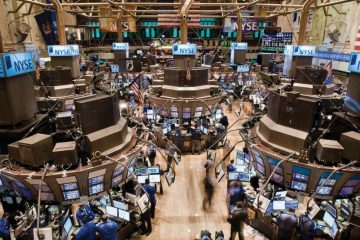The stock market seems to really like Donald Trump. Despite widespread predictions that equities would tank if the maverick billionaire scored an historic upset—and collapsing futures around midnight that appeared to confirm the disaster scenario—Americans’ 401(k) plans have prospered since Election Day. Since the close on November 8, the S&P 500 has added 1.4% to close at 2167 on Thursday; that surge boosted the S&P’s gain for 2016 from 4.8% to 6.2%, or almost one-third. The Dow, meanwhile, closed at a record 18,808 on Thursday.
Setting aside fears of trade wars, Wall Street has embraced the idea that a President Trump opens at least the possibility of a breakthrough that seemed a total long-shot before: An era of far faster growth than the tepid expansion America’s experienced in recent years.
“Trump’s policies are generally asset and market friendly,” with the notable exception of trade policy, Goldman Sachs CEO Lloyd Blankfein said Thursday at the Dealbook conference in New York. “The totality of positions he’s staked out…more fiscal spending and lower taxes, potentially lighter regulation; that’s a combination…very supportive of asset prices, very supportive of equities.”
The President-elect has proposed a series of controversial, but highly ambitious proposals for super-charging the economy. If they work, and it’s far from certain they will, Americans’ portfolios could flower—not as brightly as in the Reagan years perhaps—but a lot more than if the nation continues on its current course.
But don’t be fooled. Equities are really, really expensive, and Trump’s triumph just made them pricier. The most likely outcome is for extremely low returns for years to come. The 87% gains that the S&P posted over the past five years flowed from a confluence of two favorable trends: A rapid rise in earnings from the post-crisis trough, and an explosion in price-to-earnings (P/E) multiples, the price investors are willing to pay for each dollar of those earnings.
Earnings-per-share, measured over the preceding 12 months, crested in the third quarter of 2014 at $ 85.02, down 20% from their peak of $ 106 two years earlier. And P/Es now stand at 24, far above the average of 19 since 1990, which is itself a lot higher than the century-old norm of 16.
Hence, it’s probable that multiples have already maxed out. Only one factor can drive prices higher: a surge in corporate profits. Trump has pledged to cut the corporate tax rate to 15% from 35%, which would immediately benefit corporate profits. But a sustained bull market in corporate earnings can only occur if the economy booms.
“We never had the rebound you expect after the financial crisis,” says economist Arthur Laffer, an advisor to President Reagan. “Under a President Trump, we could grow at over 6% at first, and achieve long-term growth rates of 3.5%.”
How the Trump Math Adds Up
Let’s assume the P/E remains about where it is today. Market math dictates that if the multiple remains constant, investors will pocked a return equal to the dividend yield plus the growth in earnings per-share.
Over the long-term, earnings per share typically grow about 2 points below the rate of expansion in the national income. It’s true that total corporate earnings follow GDP. But earnings per share lag by about two points because companies are constantly diluting existing shareholders by issuing new stock for acquisitions and options. The “two-percent dilution” phenomenon was documented in a 2004 article of two top experts on the science of stocks, Robert Arnott and William Bernstein.
Over the past four years, GDP has increased at 2.2% a year and the figure for the last four quarters is just 1.5%. So let’s pick the higher figure, and forecast that national income waxes by 2.2% in the future. So in this “no change” scenario, future returns would amount to the dividend yield of 2.1%, plus earnings growth of 0.2% (that’s 2.2% GDP minus the ‘2% dilution’), plus inflation of 2 points, for a total of 4.3%.
Now, let’s imagine that the Trump program delivers durable 3.5% growth. In that case, earnings per share would rise at more like 1.5% (3.5% GDP growth minus 2% dilution), so total returns, including a 2.1% dividend yield, would swell to 3.6%, plus 2% inflation, or 5.6%. That difference of 1.3% in annual returns—5.6% at a 3.5% GDP growth rate versus 4.3% at the recent average of 2.2%—doesn’t sound like much, but it would make a big-cap portfolio almost 50% more valuable a decade from now. At the end of 10 years, investors would register gains of 72%, compared with 49% if GDP keeps trudging along at 2%.
From here, the future of stocks is all about earnings. Until Nov. 8, the outlook for profits was a dreary “more of the same.” Now, a breakout is possible. But only if President Trump can mold his jumbled economic plan into a pro-growth juggernaut that brings what been missing for years: A surge in animal spirits, kindled by a sense in the C-suite that America’s future is full of promise.


